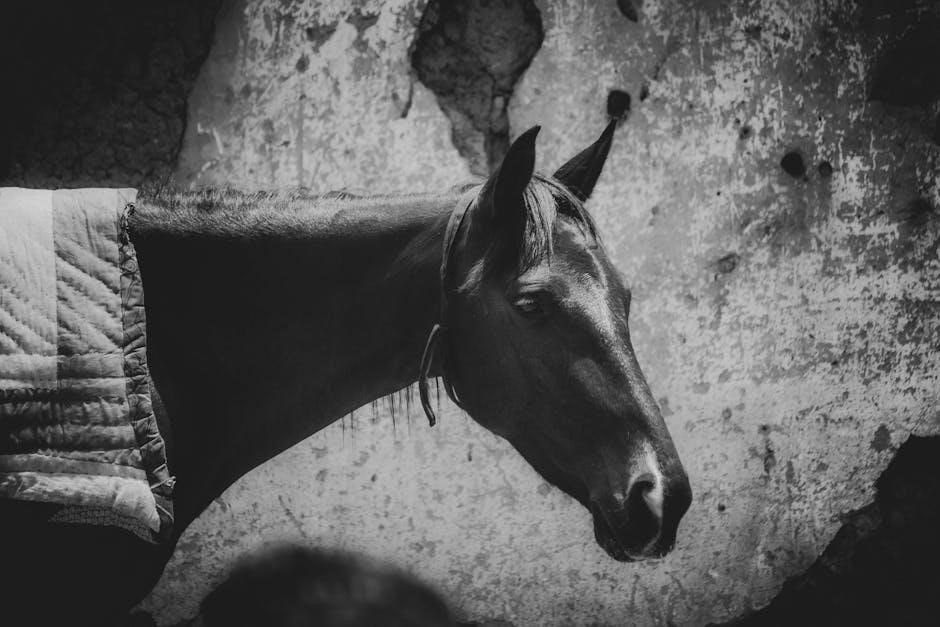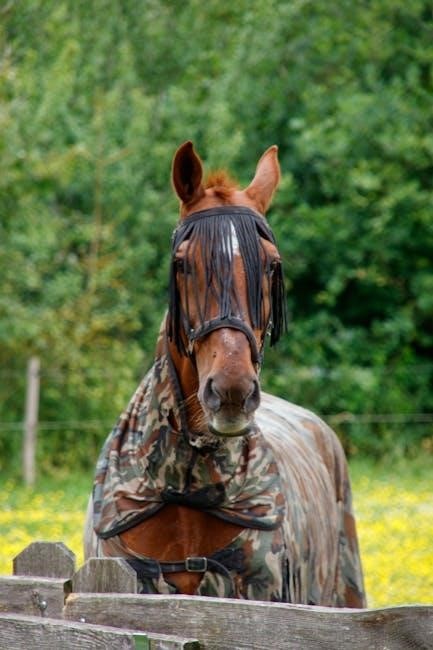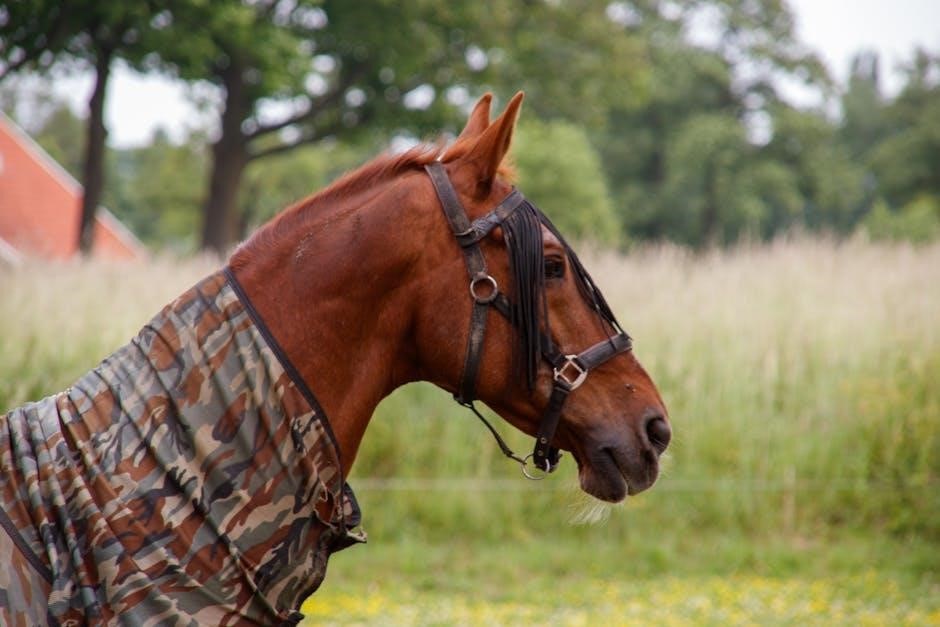Horse blankets are essential for maintaining your horse’s body heat, especially in cold weather. They come in types like turnout and stable blankets, designed to protect your horse from harsh conditions while ensuring comfort and warmth. Understanding when and how to use them is crucial for your horse’s well-being. This guide will help you make informed decisions about blanketing your horse effectively.
Why Horse Blankets Are Important
Horse blankets are crucial for protecting your horse from harsh weather conditions and maintaining their body heat. They prevent shivering, which can lead to energy loss and discomfort. Blankets also shield your horse from wind, rain, and cold temperatures, ensuring their overall well-being. Additionally, they are especially vital for clipped, older, or underweight horses, which may struggle to stay warm naturally. Regular use of appropriate blankets helps maintain your horse’s health and comfort year-round.
Purpose of This Guide
This guide is designed to provide a comprehensive understanding of horse blanketing, helping you make informed decisions for your horse’s comfort and health. It covers when to blanket, types of blankets, measuring for fit, and seasonal considerations. Whether you’re a seasoned owner or new to horse care, this guide offers practical advice to ensure your horse stays warm, dry, and comfortable in varying weather conditions. It serves as a valuable resource for all your horse blanketing needs.

Understanding When to Blanket Your Horse
Understanding when to blanket your horse involves monitoring temperature, weather conditions, and your horse’s coat. Factors like age, health, and whether your horse is clipped also play a role.
Temperature Guidelines for Blanketing
Temperature plays a crucial role in deciding when to blanket your horse. Generally, horses may need blanketing when temperatures drop below 40°F, especially if they are clipped or have thinner coats. For clipped horses, a blanket is often necessary at temperatures around 55°F to prevent chilling. Healthier horses with thick coats might not need blanketing until temperatures are significantly lower. Monitoring your horse’s comfort and adjusting based on individual needs is essential for optimal care.
Weather Conditions That Require Blanketing
Weather conditions like rain, wind, and extreme cold snaps necessitate blanketing to protect your horse from harsh elements. Waterproof turnout blankets are ideal for rainy or windy weather, preventing moisture from reaching the horse’s coat. In freezing temperatures, especially with drafts, blanketing helps maintain body heat. Always monitor weather forecasts to ensure your horse is adequately protected, as exposure to severe weather without proper covering can lead to discomfort or health issues. Blanketing is a vital step in safeguarding your horse’s well-being during unfavorable conditions.
Horse Coat and Blanketing Needs
A horse’s natural coat thickness determines blanketing needs, as it adapts to seasonal changes. Horses with a heavy winter coat may need lighter blankets, while those with clipped coats require more insulation. Monitoring your horse’s comfort is key, as over- or under-blanketing can cause discomfort. Clipped horses, lacking natural insulation, often need consistent blanketing in cold weather. Consider your horse’s age, health, and lifestyle to tailor blanketing strategies, ensuring their coat and overall well-being are protected effectively.

Types of Horse Blankets
Horse blankets vary, including turnout, stable, and lightweight options. They may feature fill for warmth or be unfilled, catering to different weather and seasonal needs effectively.
Horse Sheets vs. Horse Blankets
Horse sheets and blankets differ in design and purpose. Sheets are lightweight, often without fill, suitable for mild weather or as a base layer. Blankets, with or without fill, provide warmth in colder conditions. Turnout blankets are waterproof, while stable blankets are for indoor use. Sheets are ideal for spring or fall, whereas blankets are essential for winter. Understanding their differences helps ensure your horse stays comfortable and protected in varying weather conditions throughout the year.
Lightweight, Medium, and Heavy Blankets
Lightweight blankets are ideal for mild weather or clipped horses, offering minimal warmth without bulk. Medium-weight blankets provide balanced protection in cooler temperatures, while heavy blankets are designed for extreme cold. Fill power varies, with lightweight options having little to no fill and heavy blankets offering maximum insulation. Materials like polyester ensure durability, and features such as waterproofing add functionality. Choosing the right weight depends on your horse’s needs, climate, and activity level to ensure comfort and prevent overheating.
Turnout vs. Stable Blankets
Turnout blankets are designed for outdoor use, typically waterproof and durable to withstand harsh weather conditions. They often feature a breathable lining to prevent moisture buildup. Stable blankets, on the other hand, are intended for indoor use, offering warmth and comfort in a dry environment. While turnout blankets prioritize protection from the elements, stable blankets focus on providing insulation without the need for water resistance, making them ideal for different settings and purposes.

How to Choose the Right Blanket
Consider your horse’s age, health, and whether they’re clipped to determine the best blanket. Assess their lifestyle and climate to ensure optimal comfort and protection.
Consider Your Horse’s Age and Health
Your horse’s age and health significantly influence blanketing needs. Older or unwell horses may require heavier blankets to maintain body heat. Clipped horses, lacking natural insulation, need extra care. Monitor their condition and adjust blanketing accordingly to ensure comfort and prevent overheating. Proper blanketing supports their well-being, especially in colder conditions.
Blanketing for Clipped Horses
Clipped horses require extra attention when it comes to blanketing. Since their natural insulation is reduced, they need blankets to stay warm, especially in cold weather. A good rule of thumb is to blanket when temperatures drop below 55°F. Choose lightweight to heavy blankets based on the extent of clipping and weather conditions. Proper blanketing helps maintain their body heat and prevents discomfort. Always monitor their comfort and adjust as needed to avoid overheating.
Blanketing Based on Horse Lifestyle
A horse’s lifestyle significantly influences blanketing needs. Active horses or those in training may require lighter blankets to prevent overheating, while idle or older horses might need heavier ones for warmth. Horses kept outdoors in harsh weather conditions benefit from waterproof turnout blankets, whereas stable-kept horses may prefer lighter options. Always consider their activity level, living situation, and overall health when selecting the appropriate blanket type and weight for optimal comfort and protection.

Measuring Your Horse for a Blanket
Accurate measurement ensures proper fit. Measure from the center of the chest, along the side, to the point of the horse’s rump for the best size.
How to Measure Your Horse for the Best Fit
To ensure your horse’s blanket fits perfectly, measure from the center of the chest to the point of the rump. This length determines the blanket size. Always check the neckline for comfort and adjust leg straps to prevent rubbing. Proper fit prevents discomfort and ensures the blanket stays in place. Measure accurately to avoid a blanket that’s too tight or too loose, ensuring your horse can move freely and comfortably. This step is crucial for your horse’s well-being and safety.
Understanding Weight and Fill Options
Horse blankets come in various weights and fill options, offering different levels of warmth. Lightweight blankets are ideal for mild weather, while medium and heavy options provide greater insulation. Fill power determines the blanket’s ability to trap heat, with higher fill indicating more warmth. Choosing the right weight and fill ensures your horse stays comfortable without overheating, making it essential to consider their specific needs and the climate they’re in. This selection is vital for their comfort and health.
Neckline and Leg Strap Adjustments
Proper neckline and leg strap adjustments ensure a comfortable, secure fit for your horse. The neckline should sit snugly, avoiding pressure points or restriction of movement. Leg straps prevent the blanket from shifting, but should not be overly tight, as this can cause chafing or discomfort. Adjusting these features correctly prevents skin irritation and ensures the blanket stays in place, providing consistent warmth and protection. Regular checks are essential to maintain a proper fit and your horse’s comfort.

Seasonal Blanketing Considerations
Adjusting your horse’s blanket according to the season ensures their comfort and health. Lighter blankets suit spring and fall, while heavier ones are necessary for winter. Monitor temperatures properly to avoid overheating in summer.
Blanketing in Spring and Fall
During spring and fall, temperatures fluctuate, requiring careful consideration for your horse’s blanket. Lightweight options are ideal for these seasons, as they provide warmth without causing overheating. Monitor weather changes closely, as cooler mornings and warmer afternoons can affect your horse’s comfort. Spring and fall are transitional periods, so a blanket with adjustable features can be beneficial. Clipped horses may need extra protection, while those with natural coats might require less. Always prioritize your horse’s specific needs and climate conditions.
Summer Care and Monitoring
During summer, horses typically don’t need heavy blanketing, but monitoring their comfort is essential. Lightweight, breathable sheets or no blanket at all are usually sufficient. However, clipped horses or those exposed to cooler nights might require a lightweight blanket. Avoid overheating by choosing materials that allow airflow and moisture-wicking properties. Regularly check your horse’s condition and adjust blanketing accordingly to ensure comfort and prevent heat stress. Proper summer care ensures your horse stays healthy and comfortable throughout the season.
Winter Blanketing Best Practices
During winter, ensure your horse stays warm and comfortable by selecting the right blanket based on temperature and conditions. Use a heavy blanket for extreme cold and a medium one for milder days. Waterproof turnout blankets are ideal for outdoor use, while stable blankets suit indoor settings. Monitor your horse’s comfort, adjusting blankets as needed to prevent overheating. Regularly check for proper fit and ensure the blanket remains clean and dry. Older or underweight horses may need extra care to maintain body heat effectively during colder months.
Caring for Your Horse Blankets
Regular maintenance is key to extending the life of horse blankets. Proper cleaning, storage, and inspection ensure they remain effective and comfortable for your horse.
Cleaning and Maintaining Blankets
Regularly cleaning and maintaining horse blankets ensures they remain effective and comfortable. Start by brushing off dirt and debris, then hand or machine wash with mild detergent. Avoid harsh chemicals that may damage materials. After washing, allow blankets to air dry to prevent shrinkage or damage. Store clean, dry blankets in a cool, dry place to prevent mold and mildew. Regular inspections for wear and tear, such as broken straps or frayed edges, are essential for maintaining functionality and safety.
Storing Blankets When Not in Use
Proper storage of horse blankets is essential to maintain their quality and longevity. Clean and dry blankets thoroughly before storing to prevent mold and mildew. Fold or hang them neatly in a cool, dry place, such as a storage bag or container. Avoid exposure to direct sunlight or moisture. Labeling storage containers can help you quickly identify which blankets are inside. This ensures your horse’s blankets remain in great condition for future use.
Checking for Wear and Tear
Regularly inspect horse blankets for wear and tear to ensure they remain functional and comfortable. Look for holes, frayed edges, or broken buckles. Check stitching for looseness and verify waterproof coatings are intact. Ensure proper fit to avoid rubbing or chafing. Replace blankets with significant damage to prevent discomfort or exposure to the elements. Addressing issues early helps maintain your horse’s well-being and extends the blanket’s lifespan.

Common Mistakes to Avoid
- Over-blanketing or under-blanketing based on temperature and weather.
- Ignoring proper fit, leading to discomfort or restricted movement.
- Assuming all horses require the same type of blanket.
Over-Blanketing or Under-Blanketing
Over-blanketing can cause overheating, sweating, and discomfort, while under-blanketing may leave your horse feeling chilly and stressed. It’s crucial to balance based on your horse’s needs, climate, and coat condition. Monitoring temperature and your horse’s behavior helps avoid these mistakes. Clipped horses, seniors, or those in harsh weather often require extra attention to ensure the right level of coverage without overdoing it. Always consider individual factors to prevent these common errors.
Ignoring Proper Fit and Comfort
Ignoring proper fit and comfort can lead to discomfort, chafing, and even health issues for your horse. A blanket that is too tight may restrict movement, while one that is too loose can shift and cause irritation. Regularly check the fit, especially as your horse’s weight or muscle tone changes. Ensure the neckline, shoulder, and leg straps are adjusted correctly to prevent rubbing or constriction. A well-fitted blanket promotes comfort and prevents potential skin irritation or injury, ensuring your horse stays healthy and happy.
Assuming All Horses Need the Same Blanket
Assuming all horses need the same blanket is a common mistake. Each horse has unique needs based on age, health, and coat condition. For example, older or clipped horses may require heavier blankets, while younger, healthier horses might only need lightweight options. Ignoring these differences can lead to discomfort or health issues. Always consider your horse’s individual circumstances to ensure the right blanket choice, promoting comfort and preventing potential problems like overheating or inadequate warmth.
Safety Tips for Blanketing
Always ensure proper fit and secure fastening to prevent chafing or accidents. Regularly inspect blankets for wear and tear, and adjust as needed to maintain comfort and prevent overheating.
Ensuring Proper Fastening
Proper fastening is crucial for your horse’s safety and comfort. Always check buckles, straps, and leg straps to ensure they are secure and adjustable. A well-fitted blanket prevents shifting, which can cause rubbing or constriction. Regularly inspect fastening systems for wear and tear, and replace any damaged parts immediately. Proper fastening ensures the blanket stays in place, providing consistent warmth and protection without compromising your horse’s movement or comfort during winter or summer months.
Monitoring for Overheating
Regularly monitor your horse for signs of overheating, such as excessive sweating, rapid breathing, or restlessness. Ensure blankets are adjusted according to weather changes, especially in milder winter days. Remove or replace blankets if temperatures rise unexpectedly. Lighter options or no blanket may be necessary during warmer periods. Always check your horse’s comfort to prevent heat stress and maintain their well-being throughout the season.
Regular Checks for Comfort and Fit
Regularly inspect your horse’s blanket to ensure proper fit and comfort. Check for tightness, rub marks, or restricted movement, adjusting straps as needed. Ensure the blanket lies smoothly across the horse’s back and withers, avoiding bunching or shifting. Daily inspections help prevent discomfort and potential skin irritation. Adjust necklines and leg straps to allow natural movement. Proper fit is essential for both turnout and stable blankets to maintain your horse’s comfort and prevent issues.
Final Thoughts on Horse Blanketing
Understanding when and how to blanket your horse is crucial for their health and happiness. Consider their age, health, and lifestyle to make informed decisions. Always monitor weather conditions and your horse’s comfort. Proper fit and regular checks ensure safety and well-being. Remember, blanketing is about protecting your horse while maintaining their natural comfort. With careful consideration, you can keep your equine companion warm and thriving throughout the seasons. Always prioritize their needs and comfort above all else.
Encouragement to Apply the Guide
By following this guide, you can ensure your horse stays warm, comfortable, and healthy throughout the year. Understanding their needs and making informed decisions about blanketing will strengthen your bond and improve their well-being. Remember, every horse is unique, and tailoring your approach to their specific needs will make a significant difference. Take the time to apply these tips, and you’ll see the positive impact on your horse’s comfort and happiness. Happy trails ahead!